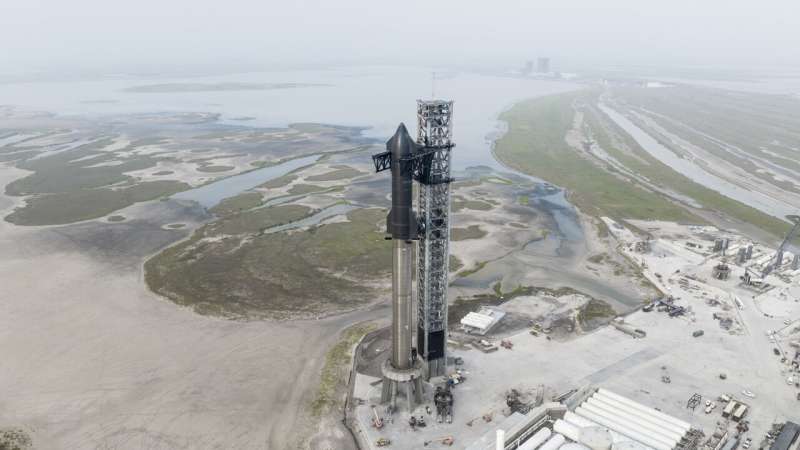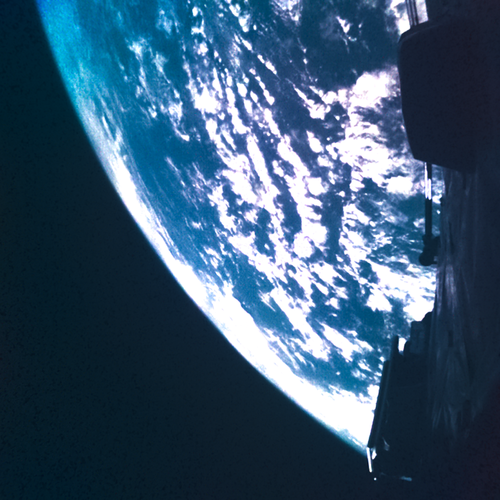Intelsat to Extend Life of Satellite with new Mission Extension Pod
Sunday, 16 April 2023 11:01 Intelsat, operator of one of the world's largest integrated satellite and terrestrial networks and leading provider of inflight connectivity (IFC), ordered a Mission Extension Pod (MEP) from Northrop Grumman Corporation's SpaceLogistics, which will add life to an Intelsat satellite and provide uninterrupted services to many customers.
The MEP "jet pack" will be installed by SpaceLogistics'
Intelsat, operator of one of the world's largest integrated satellite and terrestrial networks and leading provider of inflight connectivity (IFC), ordered a Mission Extension Pod (MEP) from Northrop Grumman Corporation's SpaceLogistics, which will add life to an Intelsat satellite and provide uninterrupted services to many customers.
The MEP "jet pack" will be installed by SpaceLogistics' What to know about 1st test flight of SpaceX's big Starship
Sunday, 16 April 2023 09:21
Elon Musk's SpaceX is about to take its most daring leap yet with a round-the-world test flight of its mammoth Starship.
It's the biggest and mightiest rocket ever built, with the lofty goals of ferrying people to the moon and Mars.
Jutting almost 400 feet (120 meters) into the South Texas sky, Starship could blast off as early as Monday, with no one aboard. Musk's company got the OK from the Federal Aviation Administration on Friday.
It will be the first launch with Starship's two sections together. Early versions of the sci-fi-looking upper stage rocketed several miles into the stratosphere a few years back, crashing four times before finally landing upright in 2021.
TrustPoint launches PNT cubesat
Saturday, 15 April 2023 14:44
TrustPoint Inc. launched its first satellite April 14 on the SpaceX Transporter-7 rideshare flight.
SpaceX launches seventh Transporter rideshare mission
Saturday, 15 April 2023 14:36
SpaceX launched more than 50 satellites early April 15 on the latest in a series of dedicated Falcon 9 smallsat rideshare missions.
Exolaunch deploys 21 satellites on Transporter-7 rideshare mission
Saturday, 15 April 2023 12:56 Exolaunch has successfully deployed 21 satellites on SpaceX's Transporter-7 mission. The mission was launched using a SpaceX Falcon 9 on April 14 at 11:48pm PT from Vandenberg Space Force Base in California, USA. This is the 19th mission in Exolaunch's flight heritage, bringing it to a well-rounded 290 satellites launched and taking the Company ever closer to the 300 satellites milestone.
Exolaunch has successfully deployed 21 satellites on SpaceX's Transporter-7 mission. The mission was launched using a SpaceX Falcon 9 on April 14 at 11:48pm PT from Vandenberg Space Force Base in California, USA. This is the 19th mission in Exolaunch's flight heritage, bringing it to a well-rounded 290 satellites launched and taking the Company ever closer to the 300 satellites milestone. HawkEye 360's latest Cluster 7 satellites successfully launched
Saturday, 15 April 2023 12:56 HawkEye 360 Inc has reported that its Cluster 7 next-generation satellites have deployed in orbit after launching aboard a SpaceX Falcon 9 rocket from Vandenberg Space Force Base in California during the Transporter-7 mission. Communication with the satellites has been established by the company's operations team.
"We are pleased to report that our Cluster 7 satellites have deployed to orb
HawkEye 360 Inc has reported that its Cluster 7 next-generation satellites have deployed in orbit after launching aboard a SpaceX Falcon 9 rocket from Vandenberg Space Force Base in California during the Transporter-7 mission. Communication with the satellites has been established by the company's operations team.
"We are pleased to report that our Cluster 7 satellites have deployed to orb Momentus launches Vigoride-6 OSV on SpaceX Transporter-7 Mission
Saturday, 15 April 2023 12:56 Momentus Inc. (NASDAQ: MNTS) has launched its third Vigoride Orbital Service Vehicle (OSV) to low-Earth orbit aboard the SpaceX Transporter-7 mission on April 14. Momentus established contact with its Vigoride vehicle and confirmed that both solar arrays are deployed and the vehicle is generating power and charging its batteries.
The Vigoride-6 mission will deliver two satellites to a cust
Momentus Inc. (NASDAQ: MNTS) has launched its third Vigoride Orbital Service Vehicle (OSV) to low-Earth orbit aboard the SpaceX Transporter-7 mission on April 14. Momentus established contact with its Vigoride vehicle and confirmed that both solar arrays are deployed and the vehicle is generating power and charging its batteries.
The Vigoride-6 mission will deliver two satellites to a cust Juice sends first ‘selfies’ from space
Saturday, 15 April 2023 10:24
ESA’s Jupiter Icy Moons Explorer (Juice) has taken its first monitoring camera images showing part of the spacecraft with Earth as a stunning backdrop.
The mission launched on an Ariane 5 from Europe’s Spaceport in Kourou on 14 April 14:14 CEST and the images were captured in the hours afterwards.
Kenya launches first operational satellite into orbit
Saturday, 15 April 2023 10:16 Kenya's first operational satellite was launched into orbit on Saturday by a SpaceX rocket that took off from California, USA, according to images from the US space company.
The launch, originally scheduled for Monday night in the United States, was postponed several times this week due to bad weather.
On Saturday, a SpaceX Falcon-9 rocket took off at 0648 GMT from the base at Vandenbe
Kenya's first operational satellite was launched into orbit on Saturday by a SpaceX rocket that took off from California, USA, according to images from the US space company.
The launch, originally scheduled for Monday night in the United States, was postponed several times this week due to bad weather.
On Saturday, a SpaceX Falcon-9 rocket took off at 0648 GMT from the base at Vandenbe Elon Musk forms X.AI artificial intelligence company
Saturday, 15 April 2023 10:16 Elon Musk has formed an X.AI artificial intelligence corporation based in the US state of Nevada, according to business documents that surfaced on Friday.
Musk, who is already the boss of Twitter and Tesla, was listed as director of X.AI Corporation founded on March 9, a state business filing indicated.
Musk recently merged Twitter with a newly created "X" shell company, keeping the bran
Elon Musk has formed an X.AI artificial intelligence corporation based in the US state of Nevada, according to business documents that surfaced on Friday.
Musk, who is already the boss of Twitter and Tesla, was listed as director of X.AI Corporation founded on March 9, a state business filing indicated.
Musk recently merged Twitter with a newly created "X" shell company, keeping the bran Kenya deploys first earth observation satellite into space
Saturday, 15 April 2023 08:39
Kenya's first earth observation satellite was launched into space Saturday after two aborted attempts earlier in the week.
The African country's Taifa-1 was among the satellites on SpaceX's Falcon 9 rocket, which lifted off from Vandenberg Space Force Base in California.
The rocket's launch had to be scrubbed twice previously due to bad weather.
Kenya's satellite will fly over the country every four days and gather data for agriculture, land and environment monitoring, according to the Kenya Space Agency.
Data from the satellite is expected in the coming months, and the agency has set up a team of analysts. It said says the information will be distributed free to government agencies and to private companies for a reasonable fee.
The satellite was developed and designed by Kenyans but manufactured at Endurosat in Bulgaria at a total cost of 50 million Kenyan shillings ($371,000).
Kenyans were eager to watch the Falcon 9's launch online. Some described having the Taifa-1 enter orbit as a moment of national pride.
The country launched an experimental nanosatellite that lifted from the International Space Station in 2018.
SpaceX will try to launch most powerful rocket ever Monday
Saturday, 15 April 2023 05:40 SpaceX plans to carry out its first test flight on Monday of Starship, the most powerful rocket ever built, designed to send astronauts to the Moon and eventually beyond.
The launch is scheduled to take place at 7:00 am (1200 GMT) from the sprawling Texas base of the private space company owned by billionaire Elon Musk.
Fallback times are scheduled later in the week if Monday's attempt i
SpaceX plans to carry out its first test flight on Monday of Starship, the most powerful rocket ever built, designed to send astronauts to the Moon and eventually beyond.
The launch is scheduled to take place at 7:00 am (1200 GMT) from the sprawling Texas base of the private space company owned by billionaire Elon Musk.
Fallback times are scheduled later in the week if Monday's attempt i Europe's JUICE mission blasts off towards Jupiter's icy moons
Saturday, 15 April 2023 05:40 The European Space Agency's JUICE space probe successfully took off on Friday for a mission to discover whether Jupiter's icy moons are capable of hosting extra-terrestrial life in their vast, hidden oceans.
The launch on an Ariane 5 rocket from Europe's spaceport in Kourou, French Guiana, came after a previous attempt on Thursday was called off due to the risk of lightning.
Despite clou
The European Space Agency's JUICE space probe successfully took off on Friday for a mission to discover whether Jupiter's icy moons are capable of hosting extra-terrestrial life in their vast, hidden oceans.
The launch on an Ariane 5 rocket from Europe's spaceport in Kourou, French Guiana, came after a previous attempt on Thursday was called off due to the risk of lightning.
Despite clou Mapping dark matter like never before
Saturday, 15 April 2023 05:40 A new groundbreaking image from one of the world's most powerful telescopes that reveals the most detailed map of dark matter distributed across one quarter of the sky, and deep into the cosmos, offers scientists a perspective that may lead to new methods to demystify dark matter.
The research that led to the image, completed by the Atacama Cosmology Telescope (ACT) collaboration, also pro
A new groundbreaking image from one of the world's most powerful telescopes that reveals the most detailed map of dark matter distributed across one quarter of the sky, and deep into the cosmos, offers scientists a perspective that may lead to new methods to demystify dark matter.
The research that led to the image, completed by the Atacama Cosmology Telescope (ACT) collaboration, also pro 

 Image:
Juice gets wings
Image:
Juice gets wings